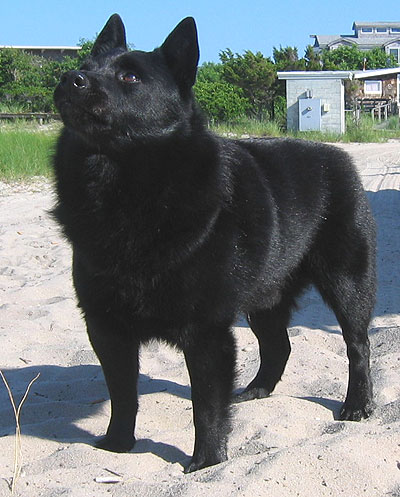
She still has a lot of puppy energy and likes to be chased around the yard and she loves doing zoomies! Sadie craves attention and affection. She is energetic and loves to run and play and should have a decent sized fenced yard and another active dog of a similar size to play with. She would not be well suited to a home with small children and she has not been tested with cats. She is very good with other dogs and would be great with older kids who are comfortable around dogs. Sadie is friendly, she just needs to sit back and observe her surroundings first. She eventually moved to the couch for a nap and then laid on the floor by her foster mom's feet! At first she slept in the living room but she eventually made her way to the bedroom and now she sleeps at night in a doggy bed by the big bed. After eating and playing outside she felt brave enough for the living room. When she first got to her foster home she hung out in the foyer for two hours. Sadie definitely needs to do things in her own time. She is a very sweet girl, but skittish around loud noises and scared if she feels pressured to do things she isn't ready for.

Read more about the Schipperke on Dogster.Meet Sadie Mae! She is a very pretty one year old, 16.6 pound Schipperke Min Pin mix! She has longer soft fur that you will love to pet! Sadie was surrendered when her owner lost her job and wasn't able to care for her. The first Schipperke came to America in the late 1800s, but the breed didn’t really catch on until the Schipperke Club of America was founded in 1929. Not just popular on boats, Schipperkes also worked with shoemakers and other shopkeepers across Belgium as guard dogs and ratters. Named after the Flemish word for “little skipper,” Schipperkes were bred by Belgian boat captains to guard unattended boats, keep rats away and provide companionship. During spring and fall shedding seasons, Schipperkes do shed, so have plenty of lint brushes handy. Their long, thick coats need regular brushing, but Schipperkes keep themselves fairly clean. Common health issues include hip dysplasia, epilepsy, cataracts and other eye problems.
#SKIPPER KEY DOG BREED FREE#
If you can allow them to run free in a controlled space, they will definitely have a blast.Ī healthy Schipperke can live as long as 15 years. They are naturally curious and independent, so always keep them on a leash in public. Once they realize everything is A-okay, they will loosen up and join the party. Because of this, they can seem a little reserved with new people. And if you happen to own a boat, this could be your ideal second mate. In spite of their size, they make excellent watchdogs. Used for hundreds of years to guard barges from thieves and rats, Schipperkes have a built-in protectiveness. Tirelessly active, they will happily keep pace with the most intense joggers. They love playing games on the carpet, but they really love to run and play outside. Small and friendly and polite, they make good use of small spaces, running in and out of rooms to satisfy their curiosity. Schipperkes are ideal for apartment living.

They get along famously with children and other pets, including cats, and they form strong bonds with their families. Loving and warm, they are eager to please, easy to train and somewhat feisty. Schipperkes combine a solid work ethic with a sense of fun. They move along with a smooth, nimble gait. Their wedge-shaped heads have pointed ears and fox-like faces, and they have small, dark eyes that give off an inquisitive expression. These thick coats grow in several different lengths around the body, including a thick ruff around the neck. Schipperkes have small, cobby, square-built bodies covered in long, harsh coats that usually come in black, but can also be found in brown, tan and red.


 0 kommentar(er)
0 kommentar(er)
